Sony’s HT-A3000 does virtual Dolby Atmos right, if you can handle the price
MSRP $700.00
“A Swiss-army knife of a soundbar that really does it all.”
Pros
- Great movie and music sound
- Excellent on-screen settings
- Airplay, Chromecast
- Highly expandable
- Convincing virtual Dolby Atmos
Cons
- Expensive for virtual Atmos
- No HDMI input
- No EQ settings
Sony’s A-Series of Dolby Atmos home theater soundbars and speakers are impressive, but they also cost a lot, with prices that begin at $1,000. That’s what makes its latest model so interesting. At $700, the HT-A3000 hardly qualifies as cheap, but it’s still the most affordable way to buy a premium Sony soundbar.
And it is indeed premium, bring in many of the features that make the A-Series ($1,000 HT-A5000, $1,300 HT-A7000, $1,800 HT-A9) a family to be reckoned with. With AirPlay, Chromecast, hi-res audio, expandability, and advanced compatibility with Sony’s Bravia XR TVs, there’s little these soundbars can’t do.
But bringing the price down to $700 means making cuts in a few areas, most notably the lack of any up-firing drivers to help deliver Dolby Atmos’ signature height-effect sounds.
So what exactly are these compromises, do they affect the enjoyment of TV and movie content, and if so, are you better off with the competition? Let’s get into it.
What’s in the box?
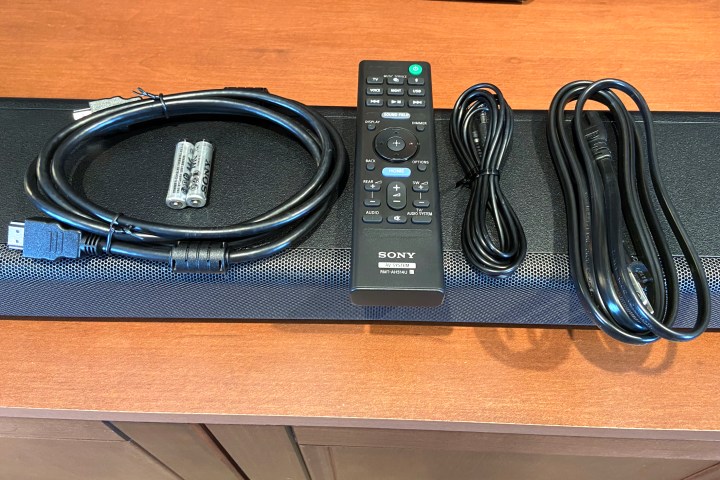
Along with the HT-A3000 (which, from here on in I’ll simply call the A3000), you get an HDMI cable, a power cable, a remote with two AAA batteries, a 3.5mm analog cable for sending center channel sound to a compatible Sony TV, a quick start guide, wall-mounting template, and a full user manual, which is nice to see — many companies are making folks head online for that documentation. It’s all packaged with big Styrofoam blocks, so you may not be able to fully recycle the material depending on where you live.
Design
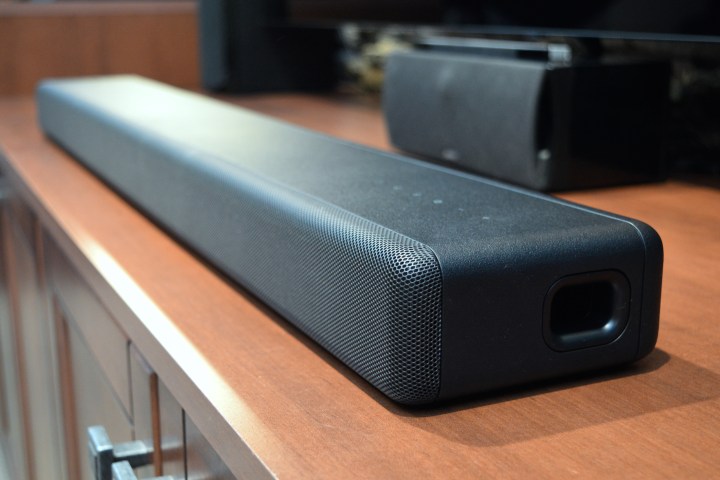
Sony is the king of the black plastic box. And while that sounds like a dis, it’s not. Soundbars, unless they are works of art unto themselves, are better heard, not seen, so the A3000’s all-matte-black plastic and dark grey metal grille are just fine with me. When the lights go down, this thing disappears, just as it should.
At 37 inches long and just a hair over 2.5 inches tall, it should fit just fine in front of any TV from 32 inches and up. If your TV happens to have very low feet and the soundbar obscures its infrared (IR) receiver, the A3000 is equipped with its own IR repeaters, so you likely won’t have to do that thing where you hold your remote way up high to control the TV.
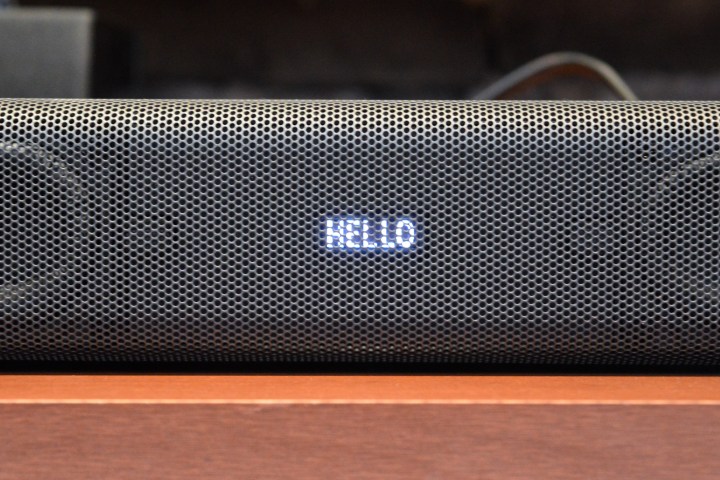
You’ll find a few touch controls on the top surface for power, volume, input selection, Bluetooth on/off, and a music service shortcut key that can be used to jump straight into Spotify if you want.
Behind that metal grille is a small OLED text display that shows you all of the status info you need from the current input, to volume level, to audio formats, if you need them. I kinda wish Sony had made it a few characters wider — many of the messages require text scrolling, which I find a hassle. But as these displays go, it’s fairly easy to read and you can dim it or turn it off entirely if it bothers you.
Setup, controls, and connections
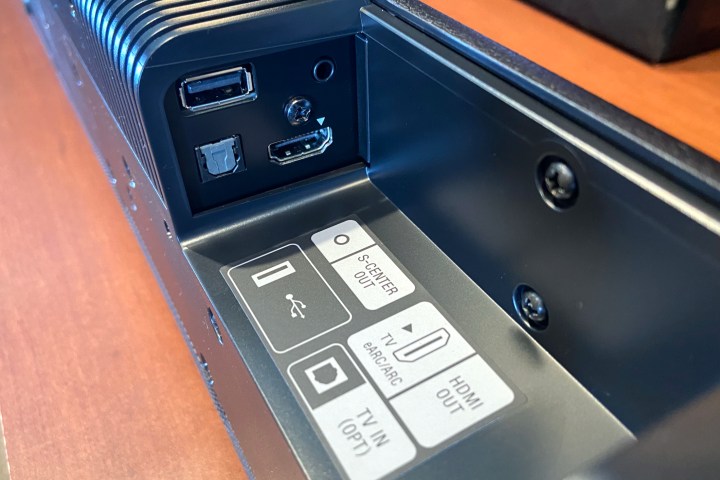
Getting the A3000 set up is really easy, mostly because you really only have one option straight out of the box: plug the included HDMI cable into the HDMI ARC/eARC port on your TV, plug the other end into A3000’s only HDMI port, turn your TV on, then turn the soundbar on. Even if you don’t go through the rest of the set up steps, you’re now good to go for TV sound.
But I strongly recommend that you do continue. Sony is one of the few soundbar companies that takes full advantage of the fact that an HDMI connection can be used to send a video signal back to a TV, and it uses that signal to give you a full on-screen menu system for the A3000.
It initially walks you through the painless process of getting connected to Wi-Fi (sorry wired network junkies, there’s no ethernet port) and once that’s done you can choose to enable Chromecast built-in and/or Amazon Alexa compatibility. These functions can be used for music streaming as well as voice commands, but they’re both optional.
Apple’s AirPlay 2, on the other hand, gets enabled as soon as you’re connected to Wi-Fi, making it a cinch to stream audio to the soundbar from any Apple device.
If your TV doesn’t support HDMI ARC/eARC, you can still connect using an optical cable, but you’ll need to supply your own, and you won’t be able to get Dolby Atmos, DTS:X, or any of the high-bandwidth surround sound audio formats like Dolby TrueHD.
The HT-A3000 does virtual Atmos better than any soundbar I’ve heard so far.
Ordinarily, you could get around such a limitation by connecting a Dolby Atmos or DTS:X source like a streaming device or Blu-ray player to the soundbar’s HDMI input, (and just use the HDMI output to send the video to your TV) but the A3000 doesn’t have an HDMI input. If you need one, you’ll have to cough up the extra $300 and buy the HT-A5000.
Sony’s Music Center companion app for iOS and Android can also be used to control the A3000, but there isn’t much call to do so. Almost everything you need can be accessed via the included remote and the OLED display, or that fantastic on-screen user interface. Still, it’s worth noting that the app can be used to access any music you have stored on a networked computer or hard drive and it can control and link any and all compatible Sony wireless speakers you may own — almost like a simplified Sonos system.
If you happen to own a relatively new Sony Bravia XR TV, you can avail yourself of the included cable and connect the soundbar’s center channel output to your TV. I didn’t have one of those TVs on hand for my testing, so I can’t say how well it works, but the gist is that the TV’s internal speakers can act as a booster for on-screen sounds, especially dialog. It’s certainly worth trying.
Finally, there’s a USB port for accessing music from storage devices. Again, I didn’t try it because I suspect most of you will use the A3000’s streaming options, but Sony does provide excellent file format support. If you can play it on a computer, you can probably play it on the A3000.
Like the soundbar itself, the included remote is typical Sony fare — boxy and basic, but clearly labeled and well laid out. You’ll need to familiarize yourself with some of the button functions, and you’ll need a light source to see it if you’re in a dimly lit room as there’s no backlighting.
Sound quality
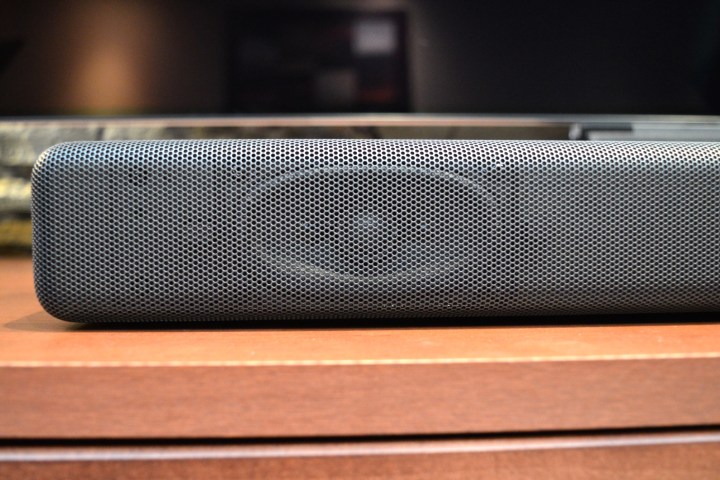
There are a few scenarios to discuss here, so let’s take them one by one.
Movies and TV
For conventional two-channel stereo and even Dolby 5.1 content, the A3000 sounds great. Dialog quality really surprised me. The A3000 lacks dedicated tweeters but despite that — and even without using the available Voice mode for speech enhancement — I found dialog very clear and intelligible, which is the first test any good soundbar must pass. Check!
The built-in dual subwoofers do an admirable job of providing low-end bass given the size of this speaker, but keep your expectations measured. This isn’t feel-it-in-your-chest bass and the monstrous T-Rex footfalls from Jurassic World Dominion won’t cause your couch to vibrate, but it’s still powerful enough to give high-octane movies real emotional impact. There’s a scene in Pacific Rim where the two main characters are surprised by a sudden noise caused by an approaching Kaiju (the movie’s monsters) and I have to admit, my heart skipped a beat, too, in spite of the lack of a dedicated subwoofer.
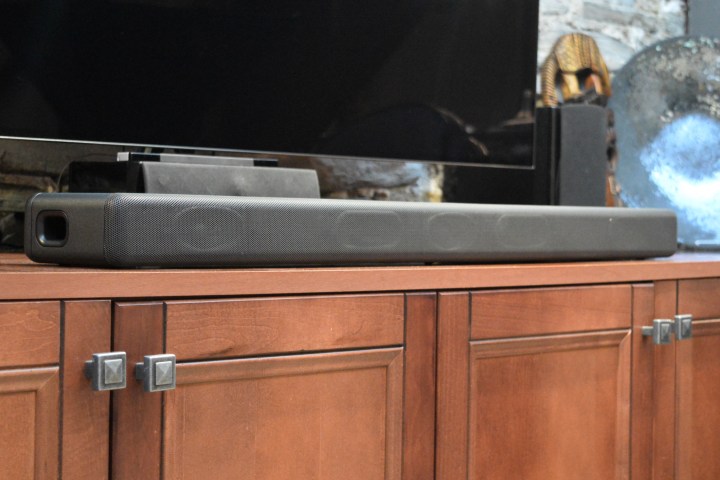
My other surprise was Dolby Atmos. I’m not going to tell you that a soundbar without dedicated up-firing drivers and a five-channel configuration can deliver the 3D immersion of Dolby Atmos as well as one that does, but the A3000 sounds better than any other I’ve tried so far.
When a soundbar doesn’t have discrete drivers for each channel, it has to virtualize them — a clever bit of digital signal processing that simulates the presence of those missing channels. How well that works depends on a number of complex factors, but let’s just say it’s a difficult trick to pull off convincingly, and many soundbars that try just can’t make it work.
But the A3000 is impressive. Close your eyes while listening to the soundtrack from Denis Villeneuve’s Dune and you can convince yourself that the sound of flying ornithopters is coming at you from speakers that are positioned well above the soundbar.
Sony 360 Reality Audio tracks were a pleasure, with a very real and immersive sound.
For Atmos and DTS:X content, that virtualization is automatic, but you can also turn on Sony’s Sound Field setting to get a similar treatment for all of your non-spatial audio content. It’s not as dramatic, but it makes shows like Amazon Prime’s The Boys way more entertaining.
Here’s the caveat to the A3000’s virtualization: It needs to be pretty loud to work. My totally unscientific playing around with levels suggests to me that at about 30% volume or less, you’ll be hard-pressed to notice much in the way of real immersion. But crank it up between 58% and 70% and now we’re talking. Your neighbors may not be as keen on the result, but it’s the immersive sweet spot for this speaker.
Music
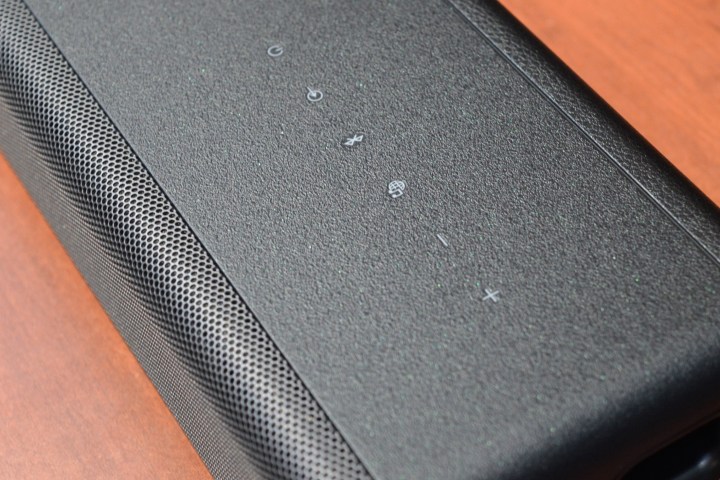
Music has always been a Sony strength and the A3000 does a good job with a wide variety of genres. The sound is nicely balanced, but there’s a bit of a hole in the midrange — it’s missing some of the detail you get from a speaker that has a greater variety of dedicated drivers. My guess is that in tuning the A3000 to do such a great job with movie/TV dialog (understandable given that this is a soundbar), some compromises had to be made along the way.
That underrepresented middle leads to a slightly colder sound, but that’s something your brain adjusts to pretty quickly. On the flip side, the clarity of the higher frequencies is excellent, if a bit sharp at louder volumes, so fans of vocal-heavy genres will find a lot to like. I sampled my favorite lossless tracks from Amazon Music, Tidal, and Apple Music and enjoyed every minute of it.
And while the overall sound signature may not satisfy music purists, the A3000 brings a lot of impressive music features to the table that help to compensate.
The first is its full suite of high-quality pathways. With both AirPlay 2 and Chromecast built-in, Apple and Android users can both stream lossless music (up to 24-bit/96kHz in the case of Chromecast), but even the soundbar’s Bluetooth connection is better than what you’ll find on most of the competition, with the lossy, hi-res LDAC codec available for Android handsets.
The second is its support for the two leading spatial-audio-for-music formats: Dolby Atmos Music (via HDMI from your TV) and Sony’s own 360 Reality Audio (360RA) via Chromecast. I wasn’t as impressed by Atmos Music on the A3000 as I have been on other Atmos-capable systems (probably because of the need for virtualization), but 360RA tracks were a real pleasure — especially live recordings like David Gilmour’s 2016 Live at Pompeii. It may seem obvious that a Sony speaker is good at reproducing a Sony format, but trust me — that isn’t always the case.
No EQ settings
There’s one drawback to sound on the A3000 and that’s its almost total lack of EQ settings. It’s an especially strange omission on a soundbar from Sony, and yet, it seems to be the approach the company has taken with its whole A-Series line. The HT-A5000 and A7000 are bereft of EQ adjustments, too, save for a few changes you can make to the Sound Field mode.
I suppose there’s an argument to be made in favor of simplicity, but I’m of the opinion that if you pay this kind of money for a home theater system, you should be able to tweak the sound here and there.
Expanding via wireless speakers
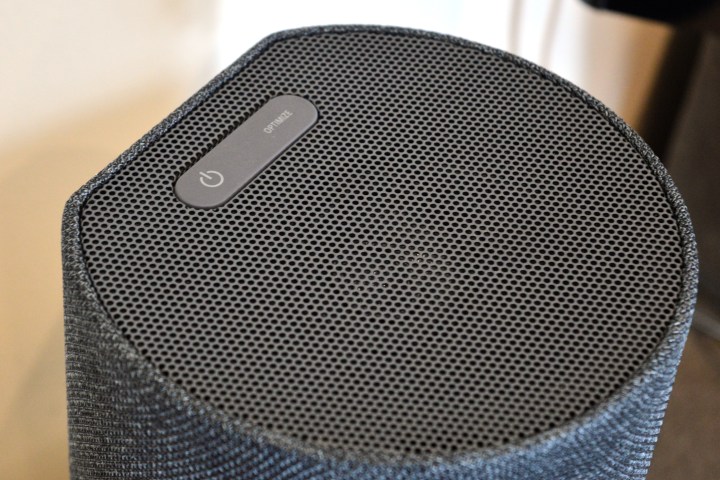
The key selling point (other than their features and sound quality) of Sony’s A-Series soundbars is their versatility. All three bar-based systems (A3000, A5000, and A7000) can be enhanced with two kinds of wireless subwoofer ($400 SA-SW3, $700 SA-SW5) and two models of wireless surround speakers ($350 SA-RS3S, $600 SA-RS5).
I tried the A3000 with the SA-SW3 sub and the SA-RS5 and, as you would expect from a system that costs $1,600, it sounded pretty great. The addition of the SA-RS5 allowed the soundbar to employ Sony’s 360 Spatial Sound Mapping, which definitely improved the immersiveness of both TV and streaming music, along with the much needed height channels.The SA-SW3 finally added that missing rumble and boom.
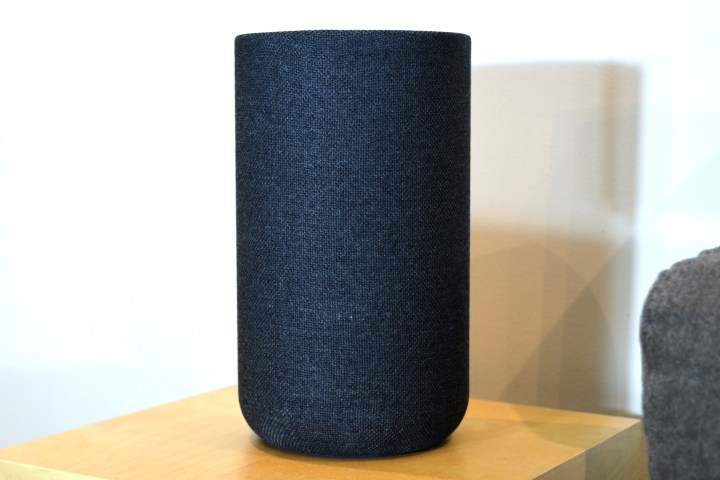
But, it’s not perfect. The problem is that when you use height drivers that reflect sound off your ceiling (as opposed to ceiling speakers that aim the sound directly downward), geometry is key. Most people will be able to find a good distance for getting the right angles from a set of front, soundbar-mounted height drivers, but the rears are much trickier.
If, like me, you have no room behind your main seating area (perhaps because your couch is up against a wall), you’ll be hard-pressed to get the needed angles from the SA-RS5. They’re designed to be positioned behind you, not beside you.
So even though the SA-RS5 will indeed turn the A3000 into a full-fledged Dolby Atmos 5.1.2 system, it’s no guarantee that you’ll get a full 5.1.2 experience.
The competition
Sony has always charged a premium price for its products, and generally speaking, they justify those premiums with better performance. But I’m not so sure that the A3000 can make that claim as easily as the A5000 or A7000.
Let’s quickly consider another option. Though I haven’t personally tested it, you can buy the Samsung HW-Q700B for the same price as the A3000.
It’s a 3.1.2 Dolby Atmos/DTS:X soundbar with up-firing front drivers and a dedicated wireless subwoofer. It supports AirPlay, Amazon Alexa, and Google Assistant, but not Chromecast. However, it sports that missing HDMI input, and it’s also expandable with a set of wireless rear surrounds that have their own up-firing drivers. If you have a compatible Samsung TV, it performs a similar function to Sony’s center-channel expansion, which Samsung calls Q-Symphony, plus, if you only want to use the soundbar for TV audio (not video passthrough), it has wireless Dolby Atmos.
And for an extra $100, you can get the Best Buy-exclusive HW-Q750B, which is essentially the same soundbar, but with the addition of hi-res audio, Chromecast built-in, and a set of wireless surround speakers for a full 5.1.2 system.
So the Sony HT-A3000 is something of a conundrum. As a Dolby Atmos soundbar, it performs beautifully for both TV and music playback, and it has an impressive number of features, all of which work well and are easy to use thanks to Sony’s thoughtful and well-executed user interface.
But its lack of dedicated height drivers, no HDMI inputs, and relatively high price (both for the soundbar as well as its compatible expansion speakers) mean you’ll need to seriously consider if it meets your specific needs. If you want a soundbar that gives you ultimate versatility for all your audio listening, plus comprehensive smart home compatibility, and you’re not the kind of person who likes to get deep into EQ settings, I think the A3000 is a great buy.
However, $700 can go a long way in the soundbar world, so if you’re less interested in being able to connect your soundbar to voice assistants and streaming music services and just want a great Dolby Atmos soundbar for movies and TV content, you can certainly spend less and still get an excellent sound system.
Editors’ Recommendations

